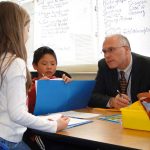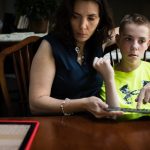“So, the interventions are usually either small groups or either individualized really focused, targeted instruction for the student to sort of catch them up and get them up to kind of speed an up to the standards for that grade level and for that age range, rather than whole cloth, you know retention. Do the whole grade again,” said Sarah Woulfin, Associate Professor at UConn Neag School of Education.
Why have suicide rates increased among teens in U.S. since the start of the COVID-19 Global Pandemic? A licensed psychologist and Neag School Board of Trustees Distinguished Professor, Sandra M. Chafouleas, joins us for a discussion and to share her thoughts on the mental health struggle of teenagers in schools.
Paul Freeman ’09 Ed.D. is in his 10thyear as the superintendent of Guilford (Conn.) Public Schools and has almost 30 years of administrative and teaching experience in schools in Connecticut. Freeman earned an Ed.D. in 2009 from the Neag School of Education. In addition to having recently been named the state’s Superintendent of the Year by the Connecticut Association of Public School Superintendents (CAPSS), he had been recognized in 2014 by the Neag School as Outstanding Superintendent of the Year.
If our nation’s cities and towns are going to be asked to do more and more, the pandemic partnerships and the progress we have made offer promise for a brighter future for our communities.
Public school enrollment in New England is down during the pandemic. But even when kids are enrolled, it can be a struggle to get some to show up. This week on NEXT, how one district is tackling absenteeism and why doctors are increasingly concerned about youth mental health. Plus, Massachusetts school districts try to cope with a teacher shortage. And when a Vermonter’s business plummeted after COVID hit, she donned an inflatable T-Rex costume and started dancing.
Children don’t come with how-to manuals. Even if they did, they would all require a manual of their own, tailored to their unique make and model. That’s why caregiving can be rewarding, as well as puzzling and demanding – particularly for family caregivers of children with disabilities. Although these caregivers often report that the role gives them a sense of purpose, it usually comes with physical, emotional and financial strains. COVID-19 has added major hurdles to accessing, delivering and evaluating special education services.
Children don’t come with how-to manuals. Even if they did, they would all require a manual of their own, tailored to their unique make and model. That’s why caregiving can be rewarding, as well as puzzling and demanding – particularly for family caregivers of children with disabilities. Although these caregivers often report that the role gives them a sense of purpose, it usually comes with physical, emotional and financial strains. COVID-19 has added major hurdles to accessing, delivering and evaluating special education services.
Sandra Chafouleas, a professor in the Neag School of Education at UConn, said that families should come up with a plan and schedule, including time away from all devices.
“Students need more support to adjust to these new times,” said Clewiston Challenger, an assistant professor at UConn’s Neag School of Education. “So school counselors, by themselves, are doing more checking on students for mental health and wellness, providing more support and making sure they’re coming to school in a virtual setting, which then leaves college exploration to be also in the background and not a top priority, which is unfortunate.”
“Distance learning with elementary students is an entirely different experience from working with them in-person,” says Kimy Velasquez, a Neag School education student. “Everything I imagined my internship to me is different from what I expected. Despite this, there are still opportunities to learn and grow as an upcoming teacher in this new environment.”



